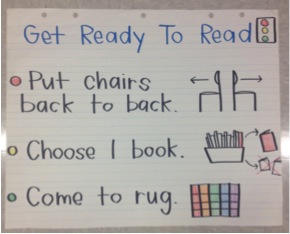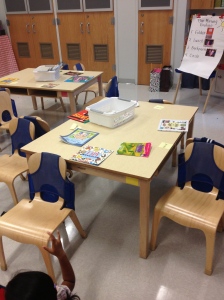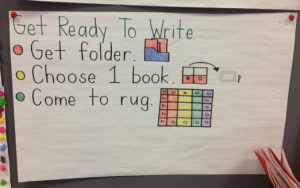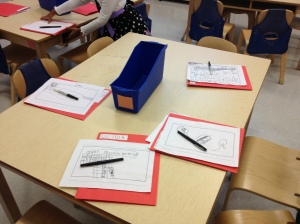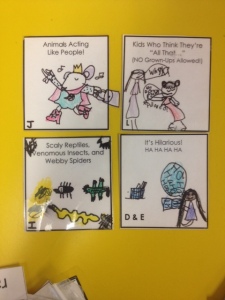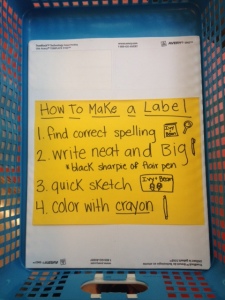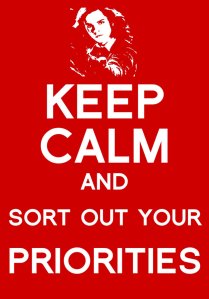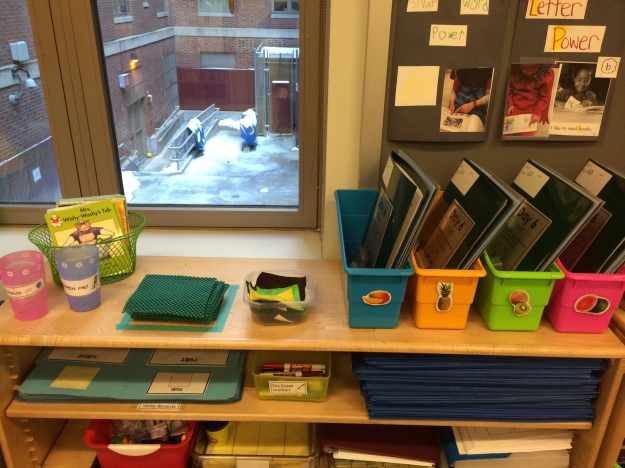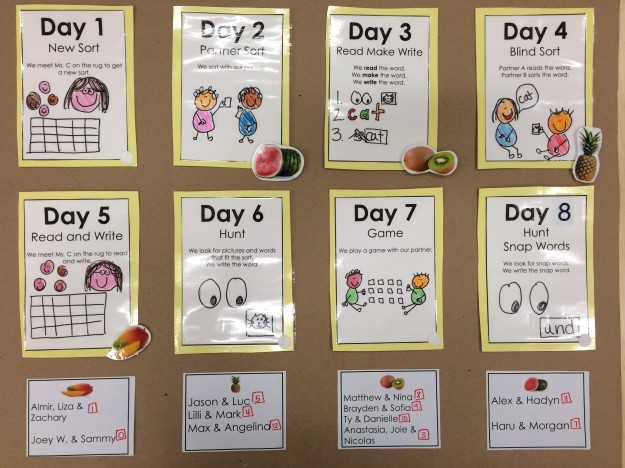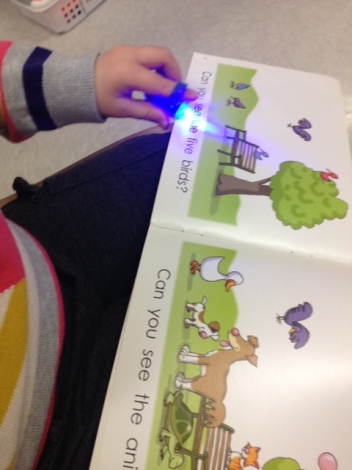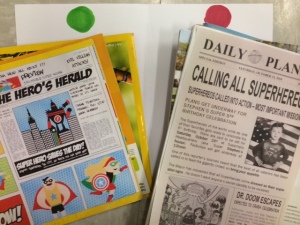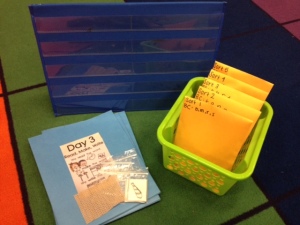word study is our favorite 20 minutes of the day. every single child is highly engaged, knows exactly what to do all by themselves (!), they’re learning in differentiated groups, and having fun, too. if you’re new to word study, here is a super quick run down on what it actually is.
- the purpose: word study helps children become efficient problem-solvers of words in reading and writing.
- our preferred word study curriculum: donald bear’s words their way
- why: it’s differentiated based on the stages of spelling development (emergent, letter-name alphabetic, within-word pattern, syllables and affixes, derivational relations), and meets the needs of all our children versus teaching the same exact thing to all our word studyers.
- assessment: the spelling inventories from donald bear and colleagues in the words their way books (you can access them inside the books.)
- resources to learn more and convince you words their way rocks: this (your school will need the full set to implement across grades) and this
- the gurus who got us word study obsessed: EM- thank you! (she blogs here: http://languageisliving.com/about/) & RR (she tweets here: @RachelARothman)
as we move forward in this post, we want to focus less on the what and the why (but if you want more of that info, consult some of the resources above) and talk more about the how so that you can make word study a favorite part of your day, too! so here’s how we get all of this up and running.
the cycle
we created an 8-day-cycle for teaching word study. eight days works nicely because it enables us to teach through one full cycle across two weeks, as long as we incorporate word study into our plans four times per week (which is easy to do at 20 minutes a pop!)
day 1: new sort – the teacher meets with students to introduce a new sort. gather your kiddos in your favorite meeting area just like you would a small reading/writing group. we introduce a new sort by saying, “today you are going to be getting a new sort! you’ve been working on paying extra close attention to the beginning parts of words. all words have a beginning part. listen closely to these words, some will have the same beginning part and others will have a different beginning part.” we’re using “beginning part” here as an example, but change the words to fit the sort you are introducing. show the students each sort card, telling/asking them what the picture is. then, ask students what they notice about the beginning parts of the words. they might be able to recognize that a lot of the words start with the same sound. next, show students the “anchor cards” or “key cards” (sort cards with a line on the bottom) and place them in separate columns (we do this right on the floor in front of the kids). sort the first few cards yourself, modeling the way you want your kids to sort. here’s how we teach our kids to sort: pick a card, “read” the card (say what the picture is), then hold the card next to each anchor card saying the card you’re holding and then the anchor card. if you are sorting beginning consonants b, m, r, s and the card you just picked is a picture of a ball, it’ll sound something like this: ball, rag (putting the ball card next to the first anchor card, rag), ball, man (moving the ball card next to the second anchor card, man), ball, bat; ball, sun. after comparing the card you drew with each anchor card, you decide where to sort your card (ball would go under the bat column since they both have the same beginning part). after you sort a few cards in front of the kids, have them try a few. it’s important that students think about why they are sorting cards in a certain way, so prompt them to think about this by asking, “why did you put that card there?” after the group is over, you will leave each partnership with their own sort bag to use for the rest of the cycle (read our next post to see how we prep and organize these).
day 2: partner sort – students work independently (no teacher) with their word study partner to sort their cards. we like giving partnerships a table tent to sort their cards in because it keeps them organized, but you could also create your own sorting mats using file folders or larger construction paper. we teach our students to put the anchor cards at the top of the table tent in different columns (one for each anchor card). the anchor cards will be the card that students use to compare all other cards against. following the sorting method mentioned for day 1, students will take turns sorting the rest of the cards. encourage partners to be helpful by saying whether they agree or disagree with their partners decision. if they disagree, teach them to give helpful advice rather than saying, “no! that card goes here.” instead, they can ask, “does bug rhyme with lock? try again!” or “do rag and ball have the same beginning sound? try again!” we also teach kids a “game” they can play once they’ve sorted all the cards called, “check it” (say it in a fun voice – turns it right into a game!) during this game, the kids read all the cards down each column, starting with the anchor card, making sure they all rhyme, have the same beginning sounds or whatever is appropriate for that particular sort.
day 3: read, make, write – we do this in slightly different ways, although the basic concept is the same. using a read, make, write mat (alyssa gives her kids a paper template for each new sort and deanna made reusable mats out of laminated file folders), students will take turns reading, making, and writing each sort card. start with cards in a pile. partner 1 draws a card and “reads” it (in the early sorts the cards are mostly pictures, so students will simply say what the picture is). partner 2 “makes” it out of a certain material. we like to change it up throughout the year but start out by using wiki-sticks. you could also have students make the word out of magnetic letters, play-do, or stamps. here, the student is writing the word the best they can. if the sort is focusing on beginning consonants b, s, and f and the card the student is making has a picture of a bat, the student is only held accountable to accurately spelling the beginning part of the word (i.e. it is okay if the student writes bt or bet because that’s not the feature they’re focusing on). next, partner 1 writes the word the best they can, following the same expectations as making the word. then they switch: partner 2 reads the next card, partner 1 makes the word, and partner 2 writes the word.
day 4: blind sort – students work with their word study partner using the table tent or sorting mat to sort the cards in a slightly different way. partner 1 reads the card without showing it to partner 2 (making partner 2 “blind”). it’s fun to have partner 2 cover their eyes while partner 1 reads it, then sorts it. once partner 1 is done sorting, they say, “look!” and partner 2 “checks” partner one. if it’s correct, partner 2 says, “ya got it!” and they high five. if it isn’t sorted correctly, partner 2 says, “go back and try it again! you can do it!” then, they switch.
day 5: read and write – this is the teacher’s second chance to visit each group within the cycle. again, gather the group in your meeting area for shared reading, interactive or shared writing, or other activity with a focus on the spelling concept the group is working on. we try to choose books for shared reading that have at least some words that align with the sort, but it’s also okay to work on that spelling concept in general. so, if your group is working on the th and sh digraphs, pick a book that has lots of words with digraphs (doesn’t necessarily have to be the specific digraphs of that sort because they are still working on reading and writing all digraphs). RR allowed us this bit of sanity…before we were scouring books for the EXACT matches to each sort. we strongly advice you NOT to do this (thank you RR!) if you’re doing shared reading, cover up some of the words that align with the sort. if you cover the whole word, you can first prompt students to think about meaning with the question, “what would make sense?” “what could go there?” if the story is about ship and the students say “boat,” that’s okay, so long as it makes sense. ask kids if there’s anything else that could go there, maybe someone will say ship. alternatively, you could start peeling back your post it to show the ‘sh’ digraph. someone will undoubtedly declare, “it can’t be boat!” “how do you know?” or “what could it be?” to spark some conversation around the visual cues kids are seeing. if you are doing shared writing, plan to co-create a book, sign, etc., with your small group that will have some words that relate to their sort. give each student a dry erase board so they can practice writing the words that relate to their sort. this is what we typically do on day 5, although you may take it as an opportunity to teach something else that group desperately needs work with, like making sure they are transferring the work of word study into that of writing workshop. you may choose to have a group bring their writing folders and look for any word that aligns to the sort to check if it is spelled right and fix it if it’s not. stretch your imagination here and dream up lots of possibilities for what you do with your kids – the options are endless (and don’t forget to share with us!)
day 6: word hunt – students work independently next to their word study partner but separately. each student needs his/her book bag with leveled just-right books and a word hunt sheet (we’ll be showing all our resources with you next week). students read their books looking for words that fit the sort. when they come across a word that fits the sort, they write the word on the word hunt sheet. now, what about when there are no words in the book that fit the sort (especially with level A/B texts)? we tell our kids to “read” the pictures, too. if they are working on the sh digraph and there is a picture of a person with shoes on, they might write the word “shoe” as best they can, only being held accountable for spelling the digraph correctly.
day 7: game – good ol’ fashioned memory or concentration, whatever you like to call it. easy to play and no extra materials required. students work with their word study partner to play the game. they set up their cards in an array, cards facing down. goal of the game: find a pair of cards that have the same spelling feature. partner 1 turns over a card and reads it, then turns over another card to try to find a match. if both cards have the same spelling feature (like ship and shell) it’s a match! partner 1 collects both cards. if the cards do not have the same spelling feature (like ship and thumb), partner 1 turns both cards back over, face down. then, it’s partner 2’s turn. we know there are many, many games out there, and many are available for download on the words their way cd. for us, in the interest of working smarter not harder, this requires no extra work on our part, and the kids are highly engaged because remember, they’re only playing this game once every 2 weeks, so they look forward to it!
day 8: word hunt (high frequency words) – students work independently next to their word study partner but separately. each student needs his/her book bag with leveled just-right books and a word hunt sheet. students read their books, looking for any high frequency word that has been taught. when they come across a HFW, they write the word on the word hunt sheet. since it’s a HFW that has already been taught and the word is right in front of them, we expect students to spell these words correctly.
where to start
what’s important to know is that we start our entire class on the same sort in the beginning of the year. we choose a sort that is far too easy for most of our kids because we want their focus to be on what we do each day in word study, NOT learning a new concept. (side note for K teachers: last year, we started with concept sorts, i.e. fruit/not fruit, but this year we decided to start with rhyming sorts so kids could practice rhyme since that’s important for ALL kinder kids, even the ones who have rhyme.) it’s all about routines, and so we invest the time in the first few months of the year doing each day of the cycle all together so kids become extremely fluent in the activity for each day. come january, we reassess our kids, change the partnerships, and put our students into differentiated groups, typically four of them (if there is more than one teacher in your room you could get away with more groups). then each group is on a different day in the cycle each day of the week, working on a sort that is developmentally appropriate for them (i.e. the ‘red group’ is on day 1, the blue group is working independently (with their partners) on day 2, the ‘green group’ independently (with their partners) on day 3, the orange group independently (with their partners) on day 4.) we recommend doing the routine whole class for 10 weeks in kinder, and 6-8 weeks in 1st & 2nd before splitting your kids into differentiated groups. (another side note to K teachers, if you’re doing the math, we didn’t start doing sorts until the end of october because we did ‘star name’ 4 times a week as our word study work at the start of the year.)
next time
we plan to share some things we’ve created, and all of our tips and tricks for selecting, making, buying, prepping, and organizing word study materials, because yes, it takes a lot of time, and yes, there are lots of materials. but, we truly feel the investment is worth it and pays off every single day, so stay tuned.
in the mean time, we’d love to know how word study goes in your classrooms, or any questions you might have that we can address in our next post. tweet at us: alyssa @alyssalnewman; deanna @dee4soul; us @primaryperks; or email us primaryperks@gmail.com
A & D
